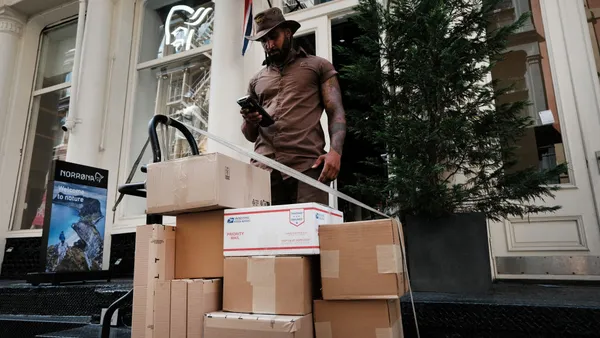Delivering to farmers is a tale of two seasons.
Before the growing season, farmers want a reliable pace of deliveries. Speed becomes much more important once the growing season kicks off as threats to their livelihoods, like unplanned pest invasions, emerge, Jack Cox, Farmers Business Network's VP of global fulfillment and logistics, said in an interview.
That need for in-season speed gave Farmers Business Network a good reason to accelerate delivery times on FBN Direct, its direct-to-farm commerce platform selling products like insecticides and seeds to farmers. The company announced last month it has achieved delivery speeds of three days or fewer for most member orders on FBN Direct.
Cox told Supply Chain Dive that the company reached that milestone around August of last year, after it debuted its in-house fleet of straight trucks. Improved inventory replenishment processes this year have helped the company achieve that target "consistently week in and week out," he said.
"It was mostly brought on by launch of the fleet, but it really grew this year with a little refinement around how we thought about our middle mile, our cross docking and our replenishment," said Cox, who has held logistics and transportation roles at Amazon, Target and Wayfair.
Improving shipping speeds to farms requires a different calculus than what's needed for home deliveries. Remote locations, imprecise addresses and sheer size of each order — Cox said the average in-season order weight is 5,000 pounds — creates additional complexities that FBN has had to consider when strengthening its logistics network.
Although a delivery address may lead a driver to a farmer's home, that farmer doesn't want "several thousands of liters of herbicide going into their house, they want it in their shed which is somewhere else on the property," Cox said.
FBN also has to be smart with its inventory positioning throughout its network, as the size of the products it sells can take up a lot of storage space.
"How do you build your local assortment for something that may or may not sell in a given year?" Cox said. "You put some in [nearby locations], but you don't expect to capture all the demand in that local area, because if you were doing that, it would be way too expensive."
Farmers Business Network leverages its hub-and-spoke network model, which includes primary fulfillment centers and smaller satellite buildings in North America, to strike the proper inventory balance and allow for easy replenishment of supply.
Farmers Business Network uses hub-and-spoke network for fast deliveries
More than 84% of growing acreage in the U.S. and 97% in Canada is within 250 miles of a Farmers Business Network logistics center, Cox said. Within these sweet spots, the company particularly leans on its in-house fleet to deliver orders during the growing season.
"When we do have customers on the East Coast where we haven't expanded our network yet, those customers are going to get a 3PL," Cox said. "It's really important to us that our drivers are in their beds every night."
FBN has also improved its "delivery optimization intelligence" to improve shipping speeds, meaning its systems now have awareness of all inventory positions in real time, according to the June announcement. This helps farmers find the fastest delivery alternative from throughout the company's entire network while factoring in more than just inventory proximity.
Farmers Business Network isn't done yet with its network improvements. In the future, FBN wants to deliver even faster when needed and expand its product assortment, Cox said.
"We just want to be a really easy, one-stop shop for everything a farmer needs," he said.
Editor's note: This story was first published in our Logistics Weekly newsletter. Sign up here.













